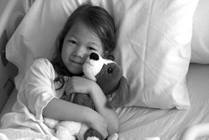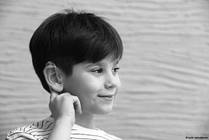Search Results
Viewing: 71-80 of 812 | All
Article
Exercises: Left Torticollis Positioning for Play
Left torticollis (tor ti COLL iss) is a tightening of the muscles on the left side of the neck. It results in your child often bending his or her head to the left side and looking to the right side. Your child may not be able to easily turn his or her head to the left due to the muscle tightness.
Article
Exercises: Right Torticollis Positioning for Play
Right torticollis is a tightening of the muscles on the right side of the neck. It results in your child frequently bending his or her head to the right side and looking to the left side.

Specialty
Pediatric Microsurgery and Facial Reanimation Program
The Pediatric Microsurgery and Facial Reanimation Program is a partnership between Nationwide Children's Hospital and The Ohio State University Wexner Medical Center. It is one of the few programs in the country offering a collaborative, multidisciplinary approach to pediatric microsurgery.
Article
Home-Based Palliative Care
Home-Based Palliative Care is designed for families whose children are facing a life-limiting condition and who are seeking support from the comfort of home.
Article
Acne Washes
Our team has compiled a list of skin washes used to treat acne. These are sold at most drug stores and you are able to buy them without a prescription.
News
Media Advisory: Giant Children to Invade Downtown Columbus on Valentines Day
WHAT: Nationwide Children’s Hospital to launch “Miracles At Play,” with the unveiling of a dramatic new downtown wallscape donated by Nationwide.
News
Nationwide Childrens Hosptial F.A.N. Club Analysis Shows Promising Results
The Nationwide Childrens Hospital Fitness And Nutrition (F.A.N.) Club was established in 2008 as part of the hospitals pediatric obesity initiative to help 3rd, 4th and 5th grade students experience fun activities to keep them fit and healthy through physical activity and education.
Nevus Sebaceous
A nevus sebaceous is a type of birthmark that usually appears on the scalp. It may also appear on the face but this is less common. It is made of extra oil glands in the skin. It starts as a flat pink or orange plaque (slightly raised area). A nevus sebaceous does not go away on its own.

Blog
What’s the Difference Between an Audiologist and Speech Language Pathologist?
While pediatric audiologists and speech language pathologists each serve different roles, they often work together to track a child’s progress and make adjustments to hearing devices or therapy to best serve a child and their family.

Blog
HIV Prevention is Possible
As we are digging ourselves out from the past two years, refocusing on preventative health care should be a priority. Before we can help prevent HIV acquisition in youth, we must understand what HIV is and how it is transmitted.
